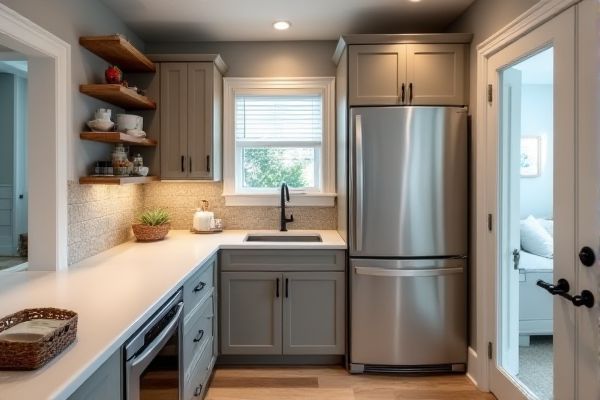
Counter-depth fridges offer a sleek, integrated look by aligning with your cabinetry, saving space in smaller kitchens while sacrificing a bit of storage capacity compared to standard-depth models that provide more room but protrude beyond counters. Explore the rest of the article to determine which fridge depth perfectly suits your kitchen design and storage needs.
Table of Comparison
| Feature | Counter-Depth Fridge | Standard-Depth Fridge |
|---|---|---|
| Depth | 24-30 inches, aligns flush with counters | 30-36 inches, extends beyond counters |
| Storage Capacity | Typically 14-20 cubic feet | Typically 20-30+ cubic feet |
| Kitchen Space | Saves floor space, sleek look | Requires more floor space |
| Cost | Higher price due to design | Generally more affordable |
| Accessibility | Easier reach, fits smaller kitchens | More storage, good for large families |
| Installation | Flush installation with cabinetry | May require extra space clearance |
Introduction to Fridge Depths
Counter-depth fridges typically measure 24 to 30 inches deep, designed to align with standard countertop edges for a seamless kitchen look. Standard-depth refrigerators usually range from 30 to 36 inches deep, offering more storage capacity but extending beyond cabinetry. Choosing between these depths involves balancing aesthetic preferences with spatial and storage needs.
What is a Counter-Depth Fridge?
A counter-depth fridge is designed to align almost flush with kitchen cabinetry, typically measuring between 24 to 30 inches in depth, compared to standard-depth models that usually extend 34 to 36 inches or more. This streamlined design enhances kitchen aesthetics and maximizes walkway space without sacrificing essential storage capacity. Popular brands like Samsung, LG, and KitchenAid offer counter-depth refrigerators featuring advanced cooling technologies and customizable storage solutions.
What is a Standard-Depth Fridge?
A standard-depth fridge typically measures 30 to 36 inches in depth, extending beyond kitchen cabinetry for maximum capacity. These refrigerators offer greater storage space with wider interiors, ideal for larger households or bulk grocery storage. Their protruding design can impact kitchen flow but provides enhanced functionality compared to counter-depth models.
Key Differences Between Counter-Depth and Standard-Depth
Counter-depth fridges typically measure between 23 to 30 inches deep, allowing for a flush fit with cabinetry and a streamlined kitchen appearance, whereas standard-depth models extend 30 to 36 inches deep, providing more interior storage space. The reduced depth of counter-depth refrigerators results in narrower shelves and less overall capacity, making them ideal for kitchens prioritizing design over maximum storage. Standard-depth refrigerators offer greater volume and flexibility for bulkier items but may protrude beyond countertops, impacting kitchen traffic flow and aesthetics.
Pros and Cons of Counter-Depth Refrigerators
Counter-depth refrigerators offer a sleek, built-in appearance by aligning flush with cabinets, saving kitchen space and enhancing design aesthetics. They typically have less storage capacity and a higher price point compared to standard-depth models, which may limit bulk food storage. Energy efficiency in counter-depth units can be comparable to standard models, but the trade-off between size and capacity remains a central consideration for buyers.
Pros and Cons of Standard-Depth Refrigerators
Standard-depth refrigerators offer greater storage capacity, making them ideal for larger families or those who require extensive food storage. Their deeper design often comes at the cost of protruding beyond cabinet lines, potentially disrupting kitchen flow and reducing available walkway space. You should consider your kitchen layout and storage needs to determine if the extra space is worth the less streamlined look.
Kitchen Space and Aesthetic Considerations
Counter-depth fridges offer a streamlined look by aligning with your kitchen cabinetry, creating more open floor space and enhancing overall room flow. Standard-depth refrigerators provide greater storage capacity but tend to protrude beyond cabinets, which can disrupt kitchen aesthetics and reduce walk space. Choosing the right depth balances your storage needs with the desired visual harmony in your kitchen layout.
Storage Capacity Comparison
Counter-depth fridges offer a sleek, built-in appearance with slightly less storage capacity, averaging 15 to 22 cubic feet, compared to standard-depth models that typically range from 18 to 28 cubic feet. Your choice depends on whether maximizing kitchen space or maximizing food storage takes priority, as standard-depth units provide more room for bulkier items and larger inventories. Efficient organization inside a counter-depth fridge can help compensate for the reduced capacity while maintaining the streamlined design.
Price and Energy Efficiency
Counter-depth fridges typically carry a higher price tag due to their streamlined design and customization options, while standard-depth models offer more affordable prices with larger capacity. Energy efficiency varies based on brand and model, but counter-depth refrigerators often consume slightly more energy to maintain optimal cooling in a compact space. Your choice should balance budget constraints with long-term energy savings and space considerations.
Which Fridge Depth is Best for Your Needs?
Counter-depth fridges offer a sleek, built-in look by aligning with your cabinetry, saving valuable kitchen space but typically provide less interior storage than standard-depth models. Standard-depth fridges extend beyond cabinets, offering greater capacity ideal for larger households or extensive grocery storage. Your choice depends on balancing kitchen aesthetics with storage needs to find the fridge depth that best suits your lifestyle and space constraints.
 homyna.com
homyna.com